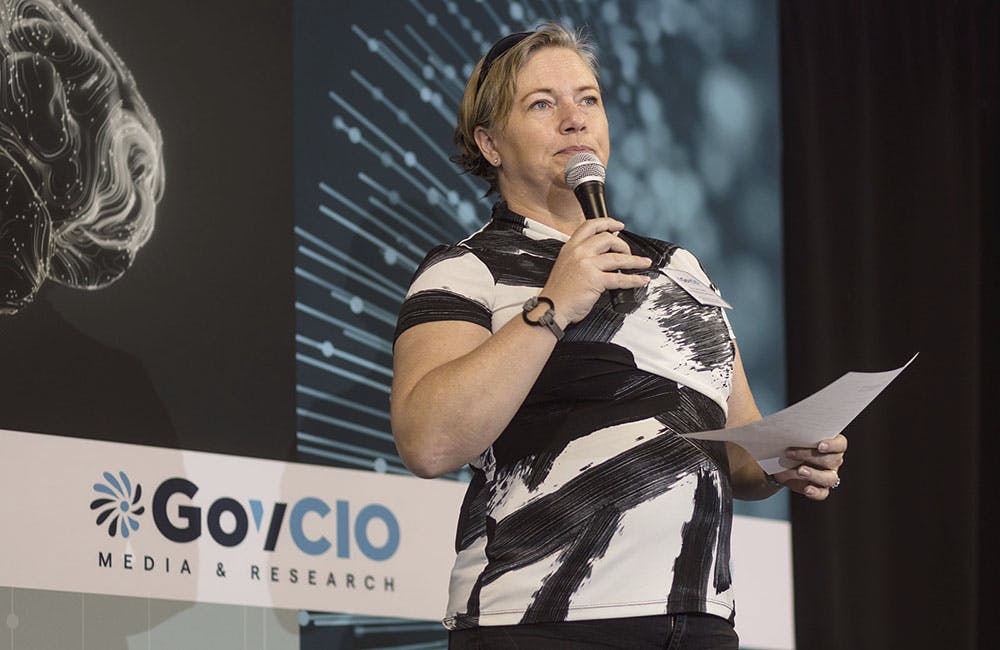How AI Could Help Federal Agencies With Their Zero Trust Strategies
DHS Deputy CTO Brian Campo said zero trust is all about how you control your data.

The heart of the zero trust approach to cybersecurity is proactive control over your data, according to Department of Homeland Security Deputy Chief Technology Officer Brian Campo.
In a virtual event hosted by NextGov last week, Campo said the first step in a zero trust strategy is recognizing there is no physical boundary anymore, just data, which security professionals must tightly control.
“Data can’t be treated as an all-in-one asset, data is not equal,” he said at the event. “We can’t give people all the access to all the data in an application. Zero trust is the really vital aspect that gives us more granular control over the endpoints you have access to as well as the data.”
A zero trust approach enables federal agencies to grant granular access to different data based on a user’s credentials and the user’s interaction history with other data sets.
“There is no predefined security. With zero trust, what you’re doing is you’re looking at every single request as a new request for a resource,” Campo said. “It’s giving us different paradigms and different defense vectors. We’ve got these sets of criteria. We’re doing policy enforcement not at the gateway anymore, we’re doing it on the endpoint. We’re doing it in different traversal points across the network. There’s no [longer] just one access mechanism anymore. On the endpoint we might be looking at GPS location, or other things that are installed on that endpoint like software applications.”
With all this user information, security professionals can make educated decisions about what level of access to grant.
“We can really build these viable identity profiles at each stage of the policy decision,” Campo said. “The other aspect that’s really interesting is we’re seeing more people work from untrusted locations. Before we could say someone was only ever going to work in a controlled building or controlled access point. Now … [they’re] on the same network in their house as a damaged computer, or their router may be compromised. Zero trust is absolutely vital.”
DHS is focused on aggregating its components’ directories of singular identities to verify users at different levels of data access, Campo said, as part of the department’s zero trust strategy.
But zero trust is more than just users, it’s also about devices and what kinds of devices a federal agency will allow on its network, an especially pertinent question as federal agencies are teleworking.
“I think zero trust is about how it integrates into the overall infrastructure,” said Kevin Finch, global security strategist for World Wide Technology, at the event. “You’re trying to establish a source of truth. That user also needs to come from a trusted device.”
Because zero trust must verify users, systems and devices continuously, Finch said federal agencies and their IT contractors should think about ways to make that verification process as seamless as possible.
“It needs to be seamless in nature,” Finch said. “Now there’s this common knowledge that we’re going to do that on the initial request and the lifecycle of the question. If something changes at the endpoint, [we have a risk profile so] now we can ingest that into the policy orchestration and it’s no longer a binary decision of yes or no. Maybe there’s a judgment call on the level of access, maybe only read access.”
Campo expects artificial intelligence to play a large role in zero trust in the future to help predict, automate and streamline access-granting decisions.
“Zero trust is all about thinking proactively,” he said. “Where do I think the user needs to go and access? That’s really where zero trust is focused. Being able to understand the types of scenarios your systems need to communicate at. Thinking proactively about what sorts of data should be traveling through my network.”
This is a carousel with manually rotating slides. Use Next and Previous buttons to navigate or jump to a slide with the slide dots
-

VA CIO Targets Modern IT and Smarter Workforce Alignment
Agency leaders told lawmakers they are focused on trimming legacy systems and restructuring its workforce to streamline operations.
3m read -

Pentagon's $200M AI Contracts Signal Broader Effort to Transform Talent
The Army is leveraging Silicon Valley, reservist programs and new hiring strategies to integrate critical digital skills in its ranks.
5m read -

AI Foundations Driving Government Efficiency
Federal agencies are modernizing systems, managing risk and building trust to scale responsible AI and drive government efficiency.
43m watch -

Inside DOD’s Push to Grow the Cyber Workforce Through Academia
Diba Hadi gives her first interview since becoming principal director of the DOD’s Cyber Academic Engagement Office.
15m listen -

Agencies Tackle Infrastructure Challenges to Drive AI Adoption
Federal agencies are rethinking data strategies and IT modernization to drive mission impact and operational efficiency as new presidential directives guide next steps.
5m read Partner Content -

Generative AI Demands Federal Workforce Readiness, Officials Say
NASA and DOI outline new generative AI use cases and stress that successful AI adoption depends on strong change management.
6m read -

The Next AI Wave Requires Stronger Cyber Defenses, Data Management
IT officials warn of new vulnerabilities posed by AI as agencies continue to leverage the tech to boost operational efficiency.
5m read -

Federal CIOs Push for ROI-Focused Modernization to Advance Mission Goals
CIOs focus on return on investment, data governance and application modernization to drive mission outcomes as agencies adopt new tech tools.
4m read -

Fed Efficiency Drive Includes Code-Sharing Law, Metahumans
By reusing existing code instead of rewriting it, agencies could dramatically cut costs under the soon-to-be-enacted SHARE IT Act.
5m read -

Agencies Push Data-Driven Acquisition Reforms to Boost Efficiency
New initiatives aim to increase visibility of agency spending, improve data quality and create avenues to deploy solutions across government.
5m read -

Data Transparency Essential to Government Reform, Rep. Sessions Says
Co-Chair of the Congressional DOGE Caucus Rep. Pete Sessions calls for data sharing and partnerships to reduce waste and improve efficiency.
5m read -

DOD Turns to Skills-Based Hiring to Build Next-Gen Cyber Workforce
Mark Gorak discusses DOD’s efforts to build a diverse cyber workforce, including skills-based hiring and partnerships with over 480 schools.
20m listen
















